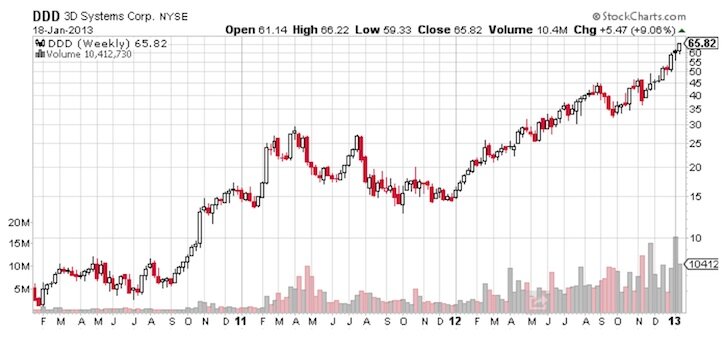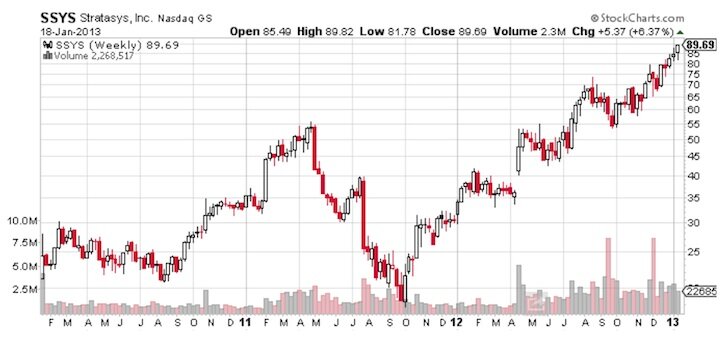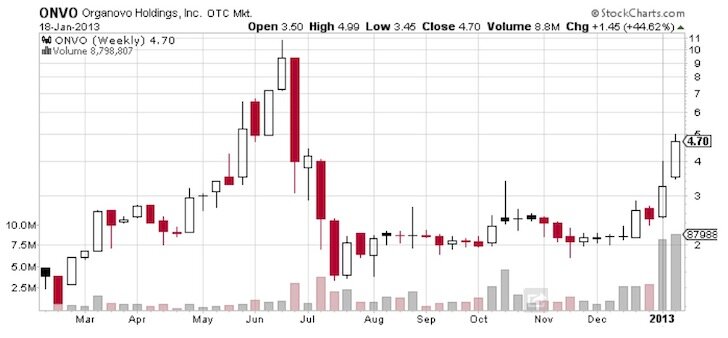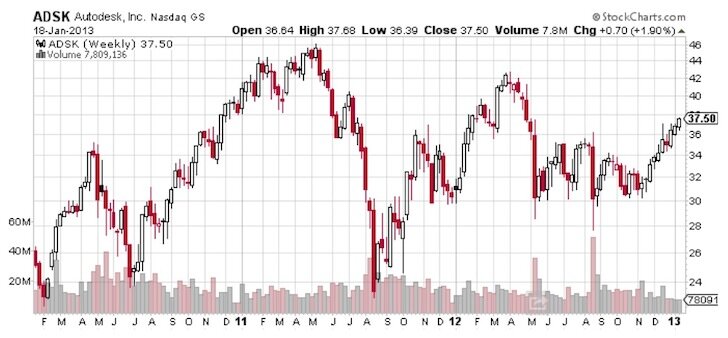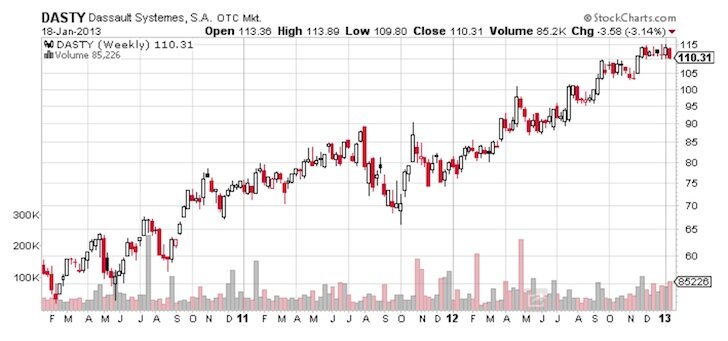With so much interest (and so much misinformation) in 3D printer-related stocks, and not having written a general overview of the landscape since October 2011, it’s time to provide an update on the subject of investing in these 3D printing companies. I’ll go through what I know about investing in these stocks, but understand that while I am an experienced investor, I am by no means qualified to provide recommendations; so I do not intend discussion of any particular investment as a recommendation to buy or sell.
Full disclosure: at the time of this writing, I own shares of 3D Systems (DDD), Stratasys (SSYS), Organovo (ONVO), Proto Labs (PRLB) and HP (HPQ). I have in the past owned shares of Autodesk (ADSK), Dassault Systemes (DASTY) and Arcam AB (AMAVF) and could buy any of them again in the future.
Overview of Investing in 3D Printer Stocks
To say that 3D printing stocks have been on a tear in recent years would be quite an understatement. The two leading publicly-traded 3D printer companies have outperformed the market significantly of late. The share prices really started moving in the fall of 2011. Since October 1, 2011, both stocks have appreciated almost 400%. Compare this to the S&P 500, which gained 32% during the same period.
The big 3D printer manufacturers
As far as your choices in investing in 3D printing stocks, two companies dominate. In fact, they dominate other companies — private and public — in the actual sales of 3D printers as well. No one else comes close. These are 3D Systems and Stratasys — both manufacturers of 3D printers, and both are profitable and growing rapidly. They also provide rapid prototyping services for industrial and commercial customers. Stratasys is focused on industrial, commercial and professional markets, while 3D Systems, also with a big footprint in those same markets, has pushed the envelope in their acquisitions into other areas of 3D printing, having purchased 30 various companies since 2008. The businesses owned and operated by 3D Systems would be an article in its own right.
When I speak of Stratasys, that now includes the Israeli company, Objet. Last year there was much speculation about whether or not they would go public or be purchased by someone like an HP, but they surprised everyone and announced a merger with Stratasys, which was finalized on December 3, 2012. Objet.com now carries the name Stratasys in their header but their printers still carry the Objet name. The combined company is now publicly traded under the symbol SSYS.
Both Stratasys and 3D Systems have market capitalizations of about three and a half billion dollars. This is much higher than they were a couple short years ago, but as leaders in what most are calling no less than the third industrial revolution, those market caps still have plenty of room to still grow. What’s a billion even get you these days? Just think about 11-employee Instagram, which last year was sold to Facebook for one billion dollars. How much more important is 3D printing than a photo app?
Speaking of acquisitions, I wouldn’t doubt that 3D Systems or Stratasys get bought out someday themselves. These days, larger companies need to buy growth, as it’s difficult for them to grow organically in this very slow economy. Frankly I’m surprised that HP has not already made a play for one of the companies, in as bad of shape as they are, and in such obvious need of something new. Seems right up their alley.
Other 3D printer makers
Two other companies that make 3D printers are Organovo and Arcam AB, but these cannot be thought of in the same categories as the two leaders. Organovo is a highly-specialized, early stage bioprinter company with terrific prospects, but profits are a long way off. And Arcam AB, while successful and growing, is a small company out of Sweden that manufactures small numbers of expensive, high-end, specialty 3D printers. It looks to be a great company, but it is a very thinly-traded stock — few shares trade each day — which can be extremely volatile and not well-suited for the average investor.
CAD software makers
Aside from the hardware, there are companies that sell the 3D modeling software (CAD programs) that engineers use to design what will come out of the 3D printers. The two market leaders, Autodesk and Dassult Systemes are not “pure play” 3D printing companies, meaning the businesses are not solely focused on 3D printing-related activities. However, they do supply the software that is most used by engineers in industrial and commercial applications. Autodesk sells the AutoCAD line and Dassault Systemes the Solidworks line — both are extremely popular, the gold standards for engineers. Autodesk is also getting into the 3D printer enthusiast market with simpler software and apps for non-engineers, but this won’t for some time add much to either the top or bottom line of a company that took in $2.3 billion last fiscal year.
More IPO’s coming…
Yesterday I just read that another maker of 3D printers has filed for an Initial Public Offering (IPO). The company is ExOne, which sells a variety of large-scale printers. We’ll keep our eye on this offering. With everyone trying to find the next DDD or SSYS, I’m certain it will go sky high the first day of its IPO if they don’t price it too richly.
IPO underwriters are certainly taking note of the enthusiasm investors have placed in 3D printer stocks, and you’ll be sure to see more IPO’s in the future. I’m hoping to see Shapeways go public sometime soon. I have a gut feeling that they are going to take the company in that direction, but I have no evidence to back this up.
There are no publicly traded companies that are solely, or even primarily, in the enthusiast-range of printers — the Makerbots of the world. 3D Systems addresses this market with their Cube and CubeX printers, but it is a very small part of their overall business.
Be careful of what people call 3D printing stocks
Something I have taken note of recently is the propensity for writers at investment sites to stretch the meaning of 3D printing. They assign the term to it either in ignorance of the difference of additive and subtractive manufacturing, or apply it too loosely.
One recent example of a non-3D printing company being called a 3D printing company is Proto Labs (PRLB), which was called such a company in an Investors Business Daily article (of all places). The company makes 3D parts from the customers’ uploaded CAD files — and does so very quickly and efficiently in a very modern looking factory — but they use subtractive manufacturing (i.e. CNC, laser cutting) as opposed to the additive technology of 3D printers. However, I did still purchase shares of the stock after I read the article because I’ve seen how small stocks react when the term 3D printing is thrown about, and technically, the chart told me the stock was about to break out as well. I had intended on selling after the breakout, which it accomplished a few days later, but after some research I decided to keep the stock because I think the company really has something going for it — 3D printing or not. It’s an interesting company to look at.
Then there was the Seeking Alpha article that listed “3 exciting 3D printing-related stocks,” one of which is Cimatron (CIMT). But if you look at Cimatron calling it a 3D printing-related company is a bit of a stretch. In the same article, author Stockballer also mentioned Perceptron (PRCP). The company makes a 3D scanner and the software for it, it’s true, but there are a lot of scanners on the market and this is not all that the company does; maybe it will have “potentially greater returns compared to the 3D printing industry leaders 3D Systems Corporation and Stratasys” as the author says. Maybe I’m missing something and it will the next big thing.
The overall point is that you really have to research for yourself every company that someone calls a 3D printing stock. Don’t forget, while there are some terrific stock analysts and assorted gurus on Seeking Alpha, there are a boatload of writers that don’t know more than the next guy.
And by the way, what do I know either? At least I’m not claiming to be an expert and an certainly not advising you — just offering some information and opinions. Don’t trust anything I have to say about investing — you must perform your own due diligence.
Six 3D printing-related stocks
The stocks I discussed that are truly related to 3D printing are shown below with some quick facts, a profile and a weekly stock chart (daily in the case of Arcam). All information is as of the close of the market on January 18, 2013. Some of the profile information was taken from company profiles on company websites.
Take note how the more of a pure play the stock is, the higher the stock appreciation has been. 3D Systems and Stratasys are 100% pure plays — everything they do has to do with 3D printers — and their stock charts reflect that.
3D Systems (DDD)
Market Capitalization: 3.75 billion
Average Daily Volume: 1.9 million per day
Trailing P/E: 96.65
Forward P/E: 42 (appx)
Profile: 3D Systems is a leading, global provider of 3D content-to-print solutions including personal, professional and production 3D printers, integrated print materials and on-demand custom parts services for professionals and consumers alike. In line with their commitment to democratize access and accelerate adoption of affordable 3D printing they also provide creative content development, 3D CAD software, curation services and content downloads. Their integrated solutions replace, displace and complement traditional development and manufacturing methods and reduce the time and cost of designing new products by printing real parts directly from digital input. 3D Systems solutions are used to rapidly design, communicate, prototype and produce functional parts and products, empowering customers to create with confidence.
Comment: This stock beat other stocks in this list in 2012, with an annual appreciation of 247%. The company is extremely acquisitive, practically setting records for how many companies it purchases. There is some discussion on how much of their growth is organic and how much is by acquisition. The company is all over the place in the 3D printing industry, with many disparate companies it is absorbing. The big question: must they continue acquiring companies at the current pace to continue to grow their revenue and earnings at the rate that will satisfy investors?
Stratasys (SSYS)
Market Capitalization: 3.52 billion
Average Daily Volume: 548,563 per day
Trailing P/E: 105.52
Forward P/E: 46 (appx)
Profile: Stratasys Ltd. was formed in 2012 by the merger of Stratasys Inc. and Objet Ltd. The company manufactures 3D printers based on patented FDM and PolyJet inkjet-based technologies. Stratasys systems are used by manufacturers to create models and prototypes to aid in new product design process. Systems range from affordable desktop 3D printers to large production systems for direct digital manufacturing. Stratasys also manufacturers Solidscape 3D Printers and operates the RedEye On Demand digital manufacturing service. The company has over 1000 employees and holds over 500 granted or pending additive manufacturing patents globally. The company’s range of 120 3D printing materials is the widest in the industry and includes over 100 proprietary inkjet-based photopolymer materials and 10 proprietary FDM-based thermoplastic materials.
Comment: The recent merger with Objet is not complete, making it a powerhouse in the area of professional, industrial and commercial 3D printers. The merger brings together the complementary additive technologies of FDM and PolyJet. I like the focus of the new Stratasys, and that it is not on a huge acquisition spree of all sorts of 3D printing-related businesses.
Organovo (ONVO)
Market Capitalization: 220.75 million
Average Daily Volume: 565,297 per day
Trailing P/E: n/a
Forward P/E: n/a
Profile: Organovo has developed and is commercializing the Novogen MMX 3D bioprinter platform technology for the generation of 3D human tissues that can be employed in drug discovery and development, biological research, and as therapeutic implants for the treatment of damaged or degenerating tissues and organs. With bioprinted nerve grafts having already been implanted into rats, Organovo anticipates human trials of bioprinted tissues as early as 2015. Before this time, the company expects its first clients to be medical researchers who will be able to test drugs on Novogen MMX bioprinted organs.
Comment: I look at this company in two ways: as a longterm investment and as a trading vehicle. Even as a long term investment, you have to realize that this is a high-risk, early stage company. It’s always possible it may not even exist in the future. But I’m betting it will with a reasonably-sized allocation. I also trade other shares of the stock at times. I like how they are now working with Autodesk on new 3D modeling software for their Novogen printer. They have also enough cash to last what looks like a couple years with no further funding, and are actively making moves to be able to uplist to the NASDAQ. For a microcap stock, it has a healthy average daily volume, so I am not worried about lack of liquidity.
Autodesk (ADSK)
Market Capitalization: $8.43 billion
Average Daily Volume: 224.7 million per day
Trailing P/E: 35.38
Forward P/E: 13 (appx)
Profile: Autodesk, Inc., is a leader in 3D design, engineering and entertainment software. Customers across the manufacturing, architecture, building, construction, and media and entertainment industries use Autodesk software to design, visualize, and simulate their ideas before they’re ever built or created. Through their apps for iPhone, iPad, iPod, and Android, they’re also making design technology accessible to professional designers as well as amateur designers, homeowners, students, and casual creators. Since its introduction of AutoCAD software in 1982, Autodesk continues to develop the broadest portfolio of state-of-the-art 3D software for global markets.
Comment: Autodesk is not a pure play in 3D printing, but it’s the leader in providing the software that engineers use to create the CAD files necessary for complex models that will be 3D printed. Since it is such a large company with many products across many industries you will have to judge how much you believe 3D printing will help the company to grow. But even beyond 3D printing, the use of CAD software is growing at a quick pace. Although you will have to determine how Autodesk competes with heavyweights such as Solidworks, free software such as Blender, and all the new 3D modeling programs that are popping up.
Dassault Systemes (DASTY)
Market Capitalization: $13.63 billion
Average Daily Volume: 13.655 million per day
Trailing P/E: 33.04
Forward P/E: 22 (appx)
Profile: Dassault Systèmes calls itself the 3DEXPERIENCE Company, and provides business and people with virtual universes to imagine sustainable innovations. Its 3D design software, 3D Digital Mock-Up and Product Lifecycle Management (PLM) solutions transform the way products are designed, produced, and supported.
Dassault Systèmes’ collaborative solutions foster social innovation, expanding possibilities for the virtual world to improve the real world. The group has over 150,000 customers of all sizes, in all industries around the globe. The important thing as it relates to 3D printing is its Solidworks applications, which include 3D Design, Data management, Simulation and Environmental assessments. SolidWorks 3D applications’ include complex part and assembly modeling, production drawing creation, data management, design validation and simulation of motion, flow and structural performance, environmental impact evaluation and publishing. SolidWorks Data Management solutions enable control over all design information, eliminating concerns about version control or data loss.
Comment: This French company is an even bigger company than Autodesk. As as with Autodesk, there is much to it outside of 3D printing. But also like Autodesk, just about everything they do is in three dimensions, resulting in a 3D print or not. I’m a little nervous about France’s recent move to tax the heck out of anything successful in the country, and the continent kicking the economic can down the road again and again (but then again, America is right behind Europe on that one). The stock chart is a thing of beauty.
Arcam AB (AMAVF)
Market Capitalization: $96.92 million
Average Daily Volume: 7,269 per day
Trailing P/E: n/a
Forward P/E: n/a
Profile: Arcam is a Swedish company founded in 1997, listed on NASDAQ OMX Stockholm, Sweden, and can be purchased in the US under the symbol AMAVF. It provides a unique Additive Manufacturing technology for production of fully dense metal parts, Electron Beam Melting (EBM). The EBM technology builds parts layer-by-layer from metal powder using a powerful electron beam. Their technology is the result of intensive research and development and has a wide array of applications within the Medical Implant industry and the Aerospace & Defense industry. In addition to the industrial applications the EBM technology is also a platform used for very active academic research. Arcam today has about 60 installations throughout the world. The systems are predominantly used in aerospace and implant applications. The EBM technology is patent-protected in 24 countries including Sweden. The trademark Arcam is protected in 21 countries.
Comment: This stock came to the limelight on December 3, 2012 when a Seeking Alpha article introduced the company to investors. That shot the stock up quite a few points. Then came another article by the same author, which propelled it into the mid 20’s, where it sits now. Arcam is a small, but seemingly impressive company. But here’s the danger: it’s a very small microcap with a very small share float of two million shares. The daily volume on the stock barely registers — prior to its introduction in December, its average daily volume was 600 shares, with more days of not one share trded than days with volume. The stock may have found a new floor in the 20’s. Or not. It doesn’t take many sellers to move a low-volume stock like this down, way down, if the sentiment changes. So, just be careful if you decide to buy shares.
Going forward
The stock prices for 3D Systems and Stratasys — the companies most people buy to invest in 3D printing — are selling at a premium. They are assuming continued high growth and no hiccups along the way. In the event of a stock market shock, or an unexpectedly poor quarterly earnings report, the prices of high-flyers can tumble. So you have to be able to stomach the downs as well as enjoy the ups. I recommend that people only invest as much as allows them to sleep at night, and diversify their holdings. You might become rich and look like a genius by putting all your money into one stock or one sector and hitting it right, but that’s also the way many more people lose most of their money. Been there, done that, before I learned the hard way.
Happy investing.

